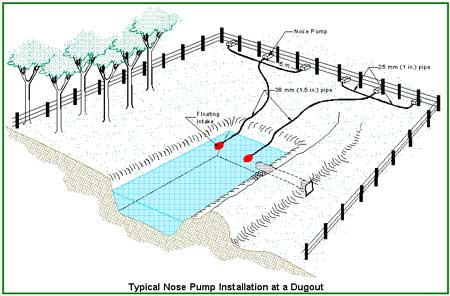| Français | Contact Us | Help | Search | Canada Site | |||||
| AAFC Online | Links | Newsroom | What's New | nbsp;Site Index |
| PFRA Online | Staff | Programs & Services | Offices | ||||
Prairie Farm Rehabilitation Administration |
||||||||
|
|
||||||||
| Download PDF version.(315KB) | |
Livestock-Powered Water PumpsWhat is a livestock-powered water pump?
How much water can a nose pump deliver?
What are the advantages of using nose pumps in a pasture watering system?Nose pumps tend to be one of the more economical ways of conveying water from the source to a remote site. Since the animals themselves supply the power for pumping, there is no need for power at the site. Nose pumps are small and light so they can easily be moved from one water source to another in intensive rotational grazing systems. What are the disadvantages of using nose pumps in a pasture watering system?Animals must be trained in the use of nose pumps, but manufacturers and producers report that most animals learn to use the systems fairly quickly, and animals also learn from each other. Young calves (<350-400 lbs) may not be able to operate nose pumps, and they are not suitable for watering sheep. An innovative way of ensuring that nose pumps can provide water for young calves is to place a pan beneath the drinking bowl of the pump assembly; the pan will collect water spilled from the drinking bowl enabling calves to drink as well. What other considerations are there in using nose pumps in a pasture watering system?Nose pumps should be securely anchored to a solid stand or fence to ensure that the lever arm can be operated without moving the entire assembly. Animals should be trained in the use of nose pumps before they go out to pasture, and animals should not be trained during periods of stress such as hot weather or immediately prior to calving. The following sketch illustrates a typical nose pump watering system which provides a protected riparian zone around a water source (in this case, a dugout). A single floating intake serves three nose pumps through a 38 mm (1½ in.) header pipe which splits into a manifold consisting of 25 mm (1 in.) diameter pipes serving each individual nose pump. 
The Bigger PictureNose pumps are only one of many options available to producers wishing to manage their rangelands and provide improved water quality for their livestock while protecting their water supplies. For additional information on other livestock watering systems, contact your local PFRA office. Sources of information for this Fact Sheet included: The Stockman's Guide to Range Livestock Watering From Surface Water Sources, available from the Prairie Agricultural Machinery Institute, P.O. Box 1060, 390 River Road, Portage la Prairie, Manitoba, R1N 3C5; Pasture Water Systems for Livestock, Agdex 400/716-3, Alberta Agriculture, Food and Rural Development http://www.agric.gov.ab.ca/agdex/400/400_716-3.html |
||||||
|
||||||||